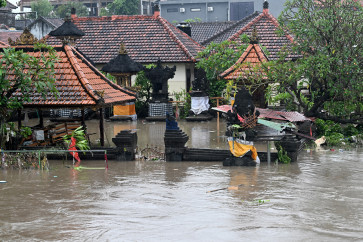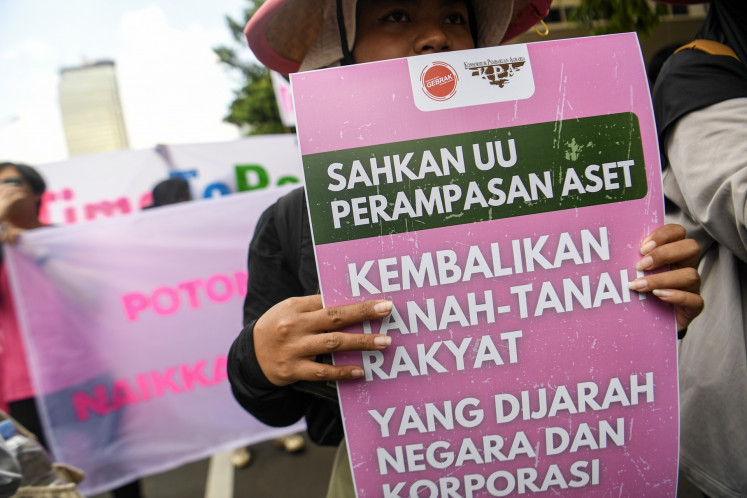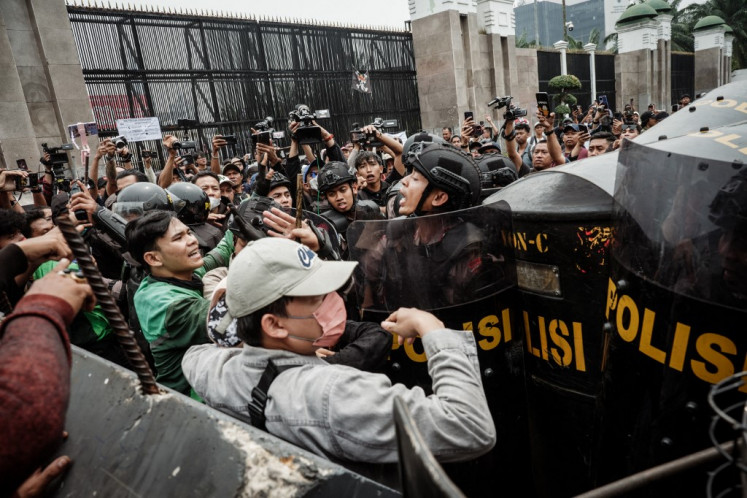Popular Reads
Top Results
Can't find what you're looking for?
View all search resultsPopular Reads
Top Results
Can't find what you're looking for?
View all search resultsCina Benteng celebrate New Year with few festivities
The temple: The Anurudha Cetiya Temple in Kampung Dongkal is one place where neighborhood residents come to pray
Change text size
Gift Premium Articles
to Anyone
The temple: The Anurudha Cetiya Temple in Kampung Dongkal is one place where neighborhood residents come to pray.
It is only a few days before Chinese New Year, or Imlek, but revelry — like the red Chinese decorations that usually color the celebrations of the day — are nowhere to be found in one neighborhood in Tangerang, West Java.
Residents of Kampung Dongkal in Pondok Jagung Timur — located right behind the high-end residential area of Alam Sutera — say that such things are not part of their lives.
“We don’t have barongsai [Chinese lion dance] or other performances here to celebrate Chinese New Year. The habits of the residents of this kampung are house visits; the younger residents visit the older ones, and then they spend the day with their own families,” said one of the residents, Marni, who has been living in Kampung Dongkal for over 20 years.
Many residents living there are of Chinese descent and are also known as Cina Benteng (Chinese of the Fort).
Talking on the terrace of her wooden Cina Benteng-style house, there are no Imlek ornaments, miniature trees to hang angpao (red envelopes containing money), red lanterns, or flower ornaments made of paper, that liven up the vibes of Chinese New Year, at her home.
“They’re expensive. In addition, it’s hard to find those kinds of ornaments around here,” said the housewife whose husband works as a wood trader.
Growing old: Mustaqim Kamil and his wife enjoy a lazy afternoon the terrace of their home in Kampung Dongkal.
But her kitchen looked different — busier than usual ahead of Chinese New Year. Stacks of homemade cookies and other traditional food, which Marni started preparing a week before Imlek, are ready to be served.
Marni said she always cooked everything by herself; from kue keranjang (sweet and sticky cake made from glutinous rice flour and caramel sugar), wajik (cake made from glutinous rice, coconut milk and sugar), to the 12 kinds of traditional meals that would be served during the day.
Some of the food, including wajik, will be used as offerings on the altar where the families pray for their deceased.
“What is more important during Imlek is the prayers we send to our deceased families,” Marni said while showing her altar.
In the Chinese calendar, the first month is marked by New Year’s celebrations. This year, Chinese New Year will fall on Feb. 10.
For some, the series of rituals starts several days before the New Year. They begin by paying homage to deceased family members by burning incense and praying in front of an altar at home.
Shortly before midnight, they pray at a temple and continue to pray in the morning. They will then gather with family, enjoy the feast and give angpao to children and unmarried relatives.
Another Cina Benteng resident in the neighborhood, Mustaqim Kamil, 60, said he only hoped for health, success and happiness for his family members in the upcoming year.
Many Feng Shui masters have offered their predictions for what will happen in the coming year — the year of the Water Snake. Some say that the year will be a good year for businesses and others say the year will not be too good for relationships.
“I don’t believe in any kind of prophecy and I don’t want to know about that. But we’re always ready for whatever happens with our lives in the future,” said the father of seven whose family has been living in Kampung Dongkal for five generations.
Mustaqim said although the celebration of Imlek in the neighborhood was never as vibrant as many Chinatowns, he was thankful that his relatives today could celebrate freely.
Sitting on a chair made of bamboo, he recalled the 1960s during the Soeharto regime when Chinese in the country could not celebrate Imlek freely. He also added that during the period he was forced to change his name from the Chinese Loa Kim Ho to an Indonesian name with an Islamic nuance.
“We could observe Imlek, but couldn’t celebrate it freely; like the family visit was only allowed for a few hours in the morning. Now, visits can last from morning until late in the afternoon,” he said.
During president Soeharto’s reign, for more than 30 years Chinese traditions were banned. Therefore, it is no wonder that many of the younger generation may have forgotten many of those traditions.
In 2000, the late president Abdurrahman “Gus Dur” Wahid removed the ban and allowed Chinese traditions to be practiced freely again. His successor, Megawati Soekarnoputri, declared Chinese New Year a national holiday in 2003.
“Although we can observe Chinese New Year freely again, I am quite disappointed to see that many younger people have stopped visiting the elderly,” Mustaqim said.
He quickly added that he was very happy to know that a new tradition of celebrating Imlek had been born in the neighborhood.
Quiet celebration: None of the red-and-gold ornaments that usually color a house during Imlek are found at this home in Kampung Dongkal, Pondok Jagung Timur, Tangerang.
“It has now become a tradition where we share our food with our friends living in other neighborhood units [RT]. They usually share some of their food with us on Idul Fitri, so we share our food with them during Imlek,” Mustaqim said.
In Tangerang, the history of Cina Benteng dates back to as early as 1407. Back then, most ethnic Chinese lived along the eastern part of the Cisadane River — now Kampung Teluk Naga.
In 1740, many Chinese living in what was then called Batavia moved to Tangerang. They were believed to have fled from the Dutch massacre of Batavia’s Chinese population.
The benteng, or fort, refers to the Dutch fort in Tangerang during the early days of Dutch colonialism that was along the Cisadane River.
The Dutch also developed several areas for Chinese people living in Tangerang that still exist today, like Pondok Cabe, Pondok Jagung, Pondok Aren and Petak Sembilan.
Most Cina Benteng today are of mixed ancestry, the result of centuries of intermarriage between the survivors of the 1740 massacre and the more recent Sundanese and Javanese trans-migrants.
— Photos by Novia D. Rulistia












